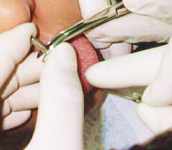 Piercing |
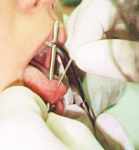 Nylon Insertion |
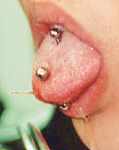 Nylon In |
 Retainer Closed |

Dermal Punches, Scalpels, and Large Gauge PiercingTom, you've been a proponent of large gauge initial piercing for quite some time now -- Why start large? Why not just stretch?
First of all, the initial question is, does the customer want jewelry, or "hardware"? For some people starting at a smaller gauge is not the best option. For people who are rough on their piercings (SM, sports, or damage through everyday activity), starting at a smaller size is more dangerous for them. The larger gauge piercing actually has a faster healing time than a smaller gauge piercing.
Why does it heal faster? Wouldn't a larger wound take longer to heal?
The larger gauge piercing provides for better drainage of the fluids that build up inside a piercing. Consider what those fluids are made up of. The main example I use to explain it to people is rotting meat. The cells that have been damaged are not repaired, but are gotten rid of. As these decompose, their byproducts are toxic to our systems, so it is very important that we facilitate the removal of these fluids.
A larger piercing also has more opportunity to breath, allowing more oxygen to enter into the wound. (This is not accomplished by using a larger gauge needle in relation to the jewelry -- This would simply result in bleeding until the tissue shrinks around the jewelry). A larger piece of jewelry also provides less stress (PSI) on the surrounding tissue due to its surface area. The only issue here is weight. The jewelry must not be too heavy, as the motion of the jewelry rocking back and forth can rub on the healing tissue and damage it. For some piercings the simple solution is to tape down the jewelry during healing. In other cases, smaller diameter jewelry or lighter weight materials may be used.
A small gauge piercing puts a lot of stress on the surrounding tissue because of its small surface area -- Any little tug or bump is constantly cutting into the tissue, thereby slowing down the healing process.
Also, your body recognizes a larger wound more quickly than it does a smaller wound. Your body's defense and healing systems kick in much stronger and more quickly. With a larger wound the initial stimulus that it produces on your immune system is much greater, so the initial healing is much faster, whereas a small piercing is recognized more like a splinter by your body.
With a large gauge piercing you must consider what is the maximum size a piercing can be done in for a given body part -- What is the most damage that area can receive and still heal itself properly? (You're not going to do a 10ga eyebrow, but you can do it in a 14ga, whereas a PA can be done in a rather large size and still heal well and quickly.)
Why use dermal punches or scalpels... Aren't needles good enough?
The basic rule for anything you are doing is use the right tool for the job. Just because something does an OK job does not mean that there isn't anything that can do it better. This is the whole premise behind the Industrial Revolution -- Take any idea and improve on it, and then improve on that... etc. etc.
A needle works by making a cut, not a coring out tissue (the coring out of tissue only happens when a cork is used too tight with the needle). The cut is made the width of the needle and then the cut is stretched up to the diameter of the needle. This produces a lot of stress on the edges of the cut, which are the weak point. In stretchy tissue, this is not a major problem. A dermal punch cuts a perfectly round hole (it does remove tissue). Therefore, the stresses on the tissue are lessened, because they are equally distributed in all directions. This also produces a stronger initial hole.
The problem with the dermal punch is the fact that it does remove tissue, not just cut. Whenever using a dermal punch this fact must be considered in relation to where it is being used -- For example, someone with rather large earlobes this does not pose a problem, but for someone with small, almost nonexistant, making a cut is a better option.
As far as scalpels go, they cannot make just small wounds as a needle would. In many ways, a scalpel and insertion taper work in the exact same manner as a needle does, but in a larger scale. But by using a scalpel and taper, the piercing can be done in a less painful way. Imagine using a 4ga needle as opposed to making a 3/16" cut and inserting an insertion taper. A scalpel also offers a slightly higher degree of control than a large gauge cut. Multiple incisions can be made to avoid damaging sensitive tissue.
The problem with scalpels is primarily the large size of the cut they make. In using a scalpel to do a piercing, there must be a lot more thought put into the piercing, strictly in the size of the piercing.
But is it Body Art?Some piercers have made the statement that surface piercings are the sign of a time when aesthetics are absent. What is your response to that?
The reason that you're seeing more surface piercings (and unusual piercings) nowadays is not due to a change in aesthetics and fashion, but due to a change in knowledge -- They are a more viable option nowadays. Previously we did not know enough about the way the body worked with piercings to heal them successfully.
We are not in a time lacking in aesthetics -- Look around -- we're in a time of change and aesthetic diversity. People have more aesthetic options nowadays than they've ever had before.
Fifteen years ago if you looked in fashion magazines, they were all showing you a similar look. But now, when you look in those same magazines, you will see pages and pages of different looks, all in the same magazine, and all "correct". We're going through a period of diversity. Instead of complying to one aesthetic, we now have the option of many.
We have opened up our eyes to many other cultures and accepted their ways even though they were strange to us, and through this we have learned to adapt our own values of aesthetics (outside of our own cultural context).
What is it that defines the line between a medical procedure and an advanced piercing procedure?
Nothing. All piercing procedures should be looked at as a medical procedure in that we are penetrating layers of tissue, even with the simplest of piercings. The same precautions must be taken no matter what we are doing.
That's really a loaded question -- a lot of the same issues come up in our industry as in medicine. However, what we're doing is not practising medicine, in the sense that we are not treating people's disorders and medical problems. We are like estiticians; we are practising beauty.
 Piercing |
 Nylon Insertion |
 Nylon In |
 Retainer Closed |
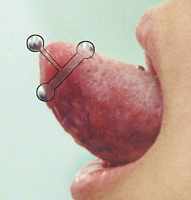 |
| Xenn Jewelry Diagram |
"Xenn" (t-bar tongue)The Xenn piercing is a three bead tongue piercing; one on the top and bottom, in forward but traditional locations, and the third on the top of the tongue. This piercing is done in several stages. First a vertical piercing is made, which is then stretched to at least an 8ga. When this piercing is healed, a second piercing is made, going from the front of the tongue and out the bottom of the first piercing. For a few days a temporary nylon retainer is worn and is then replaced by the final metal jewelry. Because the client was used to wearing a circular barbell in the tip of their tongue, there were no difficulties with teeth or speaking.
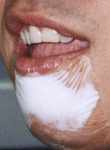 EMLA |
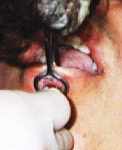 Cutting |
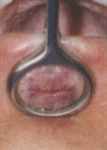 Finished Cut |
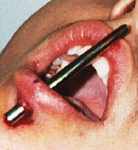 First Taper |
 Jewelry In |
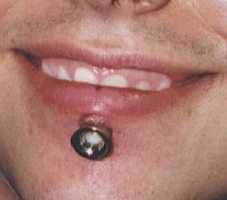
3/8" Scalpelled LabretThis piercing tested the extremes of Tom's belief that large gauge piercings heal more successfully. The client wanted to immediately start with a 3/8" (00ga) labret. With the aid of EMLA cream (a local anaesthetic) to minimize pain, an incision was made. Then, using insertion tapers, the final jewelry was tightly inserted (to minimize bleeding). Over the next days there was only minimal swelling and almost no bleeding and the tissue adapted very quickly. Within a few weeks the pierced healed entirely.
Thomas Brazda is the owner and head piercer and Toronto's Stainless Studios, located at 609 Queen St. W., (416)504-1433.
Return to BME: People